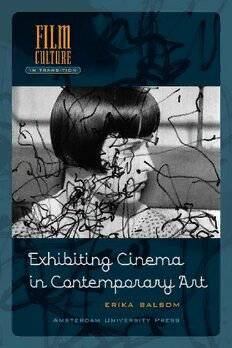
Exhibiting cinema in contemporary art PDF
Preview Exhibiting cinema in contemporary art
FFIILLMM CCUULLTTUURREE IN TRANSITION Exhibiting Cinema in Contemporary Art ERIKA BALSOM Amsterdam University Press Exhibiting Cinema in Contemporary Art Exhibiting Cinema in Contemporary Art Erika Balsom This book is published in print and online through the online OAPEN library (www.oapen.org) OAPEN (Open Access Publishing in European Networks) is a collaborativein- itiativetodevelopandimplementasustainableOpenAccesspublicationmodel foracademicbooksintheHumanitiesandSocialSciences.TheOAPENLibrary aimstoimprovethevisibilityandusabilityofhighqualityacademicresearchby aggregatingpeerreviewedOpenAccesspublicationsfromacrossEurope. Sections of chapter one have previously appeared as a part of “Screening Rooms: The Movie Theatre in/and the Gallery,” in Public: Art/Culture/Ideas (), -. Sections of chapter two have previously appeared as “A Cinema intheGallery,ACinemainRuins,”Screen:(December),-. Coverillustration(front):PierreBismuth,FollowingtheRightHandofLouise BrooksinBeautyContest,.MarkerpenonPlexiglaswithc-print,x inches.CourtesyoftheartistandTeamGallery,NewYork. Coverillustration(back):SimonStarling,WilhelmNoackoHG,.Installation viewatneugerriemschneider,Berlin,.Photo:JensZiehe,courtesyofthe artist,neugerriemschneider,Berlin,andCaseyKaplan,NewYork. Coverdesign:KokKorpershoek,Amsterdam Lay-out:JAPES,Amsterdam isbn e-isbn (pdf) e-isbn (ePub) nur / ©E.Balsom/AmsterdamUniversityPress,Amsterdam Allrightsreserved.Withoutlimitingtherightsundercopyrightreservedabove, nopartofthisbookmaybereproduced,storedinorintroducedintoaretrieval system,ortransmitted,inanyformorbyanymeans(electronic,mechanical, photocopying,recordingorotherwise)withoutthewrittenpermissionofboth thecopyrightownerandtheauthorofthebook. Everyefforthasbeenmadetoobtainpermissiontouseallcopyrightedillustra- tionsreproducedinthisbook.Nonetheless,whosoeverbelievestohaverights tothismaterialisadvisedtocontactthepublisher. Table of Contents Acknowledgements Introduction– The Othered Cinema Chapter 1–ArchitecturesofExhibition ThePassagesofCinema ProjectionandPatrimony BlackBox/WhiteCube TheNewBlockbusters TheMythofActivity MediaatMoMA Chapter 2–Filmic Ruins Post-mediumPost-mortem IndexingthePast ALittleHistoryofmm Ruinophilia AnalogueAura Chapter 3–TheRemake:Old Movies, New Narratives AmbivalentAppropriations TheFourOperations Precursors TheFalsePromisesofthe“UtopiaofUse” RemakingFandom “Room-for-Play” VCRMemories Chapter 4–TheFiction ofTruth and theTruth ofFiction Anti-anti-illusionism HybridForms RehabilitatingNarrative AReturnoftheReal TwoImagesofDeath Conclusion – “Cinema and...” 6 ExhibitingCinemainContemporaryArt Notes Bibliography Illustration Credits Index Acknowledgements Thisbookwouldnothavebeenpossiblewithoutthekindcooperationofmany individualswhoassistedintheprocessofviewingworkthatoftencirculatesin only a limited manner: Andrew Beccone, Bram Bots, and Rose Lord at Marian GoodmanGallery;JaniceGuyandFabianaVisoatMurrayGuy;RosalieBenitez andAnnaFisheratBarbaraGladstoneGallery;JamesWoodwardatMetroPic- tures;TanyaBrodskyatRegenProjects;KatherineBrinson,ArnaudGerspacher, and Sandhini Poddar at the Solomon R. Guggenheim Museum; Monika Flores at Artpace San Antonio; John Kelsey at Reena Spaulings Fine Art; Magdalena SawonatPostmastersGallery;SilviaKolbowski;MikePlunkettatDavidZwir- ner Gallery; Jessica Lin Cox and James Cohan Gallery; Christoph Draeger; Catherine Clark at Catherine Clark Gallery; Matthias Müller and Christoph Girardet;ThomasErbenGallery;GarethLong; ChrisMoukarbel; Colby Birdat Frederic Petzel Gallery; Kathryn Hillier and Bruce Hackney at Yvon Lambert Gallery; Nick Lesley at Electronic Arts Intermix; Alex Galloway/Radical Soft- wareGroup;JessicaBradleyArt+Projects;BoshkoBoskovicatSeanKellyGal- lery; Johan Grimonprez; Sarah D’Hanens atZapomatik; and Christopher Moss atPeterFreeman,Inc. Anadditionalthanksgoestothemanyindividualswhohelpedmetosecure permissiontoreproduceimagesoftheartworksdiscussedinthisbook. ThisprojectbeganasadissertationinthetrulyspecialdepartmentofModern Culture and Media at Brown University. Infinite thanks to my advisor, Mary AnnDoane,tomycommitteemembers,WendyChunandPhilipRosen,andto Michael Silverman, who was a thoughtful and encouraging voice in the early stages of this project. I am deeply grateful for the friendship and support of- fered at Brown and since by my fellow PhD students, the always-wonderful trio of Susan McNeil, Liza Hebert, and Richard Manning, and especially the gangatCharlesfield. DuringapostdoctoralfellowshipatUCBerkeley,thedepartmentofFilmand Media warmly welcomed me and helped me to negotiate the transitions from grad student to faculty member and from dissertation to book. Thank you in particular to Jonathan Haynes, Erica Levin, Kristen Whissel, Linda Williams, 8 ExhibitingCinemainContemporaryArt Federico Windhausen, and the students of my “Art and the Moving Image” seminar. ManythankstomycolleaguesinFilmStudiesatCarletonUniversity,particu- larlyMalini Guha,andtoJohnOsborne,dean oftheFacultyofArts andSocial Sciences,forhissupportofthisproject. Bart Testa, Kevin Wynter, and anonymous readers at Screen and Public pro- vided me with very helpful feedback on particular sections of the book. I am especiallygratefulfortheencouragementandcriticismofMiekeBalandUrsula Frohne. Thisprojectwouldnothavebeenpossiblewithoutfinancialsupportreceived fromBrownUniversity,theSocialSciencesandHumanitiesResearchCouncilof Canada,theAndrewW.MellonFoundation,andCarletonUniversity. Mostofall,thankyoutoCatherineBalsomandMichaelGallagher. – Introduction The Othered Cinema [T]heneedistoproposenewanswerstothequestionthatisnowraisedinallinstitu- tions dedicated to modern and contemporary art: How is film to be exhibited and howisfilmtoattainthestatusofanartwork? –BrunoRacine, president, CentreGeorges Pompidou, To open, an Overture. In , Stan Douglas produced a mm workthat re- cycledsomeofcinema’searliestimagesandoneofitsearliestgenres,thephan- tom ride. Douglas paired recycled footage from two Edison films shot in the Canadian Rockies, Kicking Horse Canyon () and White Pass, British Columbia (), with a soundtrack of passages excerpted from Marcel Proust’s In Search of Lost Time. Overture consists of three image sections, each separatedbyblackleader,andsixpassagesoftext.Thesepassagesarereadbya male voice-over through two repetitions of the image track, resulting in the same image being accompanied by different text in the second iteration of the seven-minute loop. The phantom ride celebrates technologized perception, bringing together two of its most powerful incarnations: the speed of the loco- motiveandthemechanicaleyeofcinema.Atatimewhenitwasnotpossibleto move the camera, the genre functioned as one way of enabling a mobile gaze. The iconography of the train, meanwhile, is inextricably linked to the birth of cinemathroughtheinauguralrushoftheLumières’L’Arrivéed’untrainàla Ciotat(). In Overture, the train winds around the mountains, supplies views of the landscape, and travels through tunnels of darkness, offering the spectator a glimpseofhowtraintravelwouldappearfromthefrontwindowoftheconduc- tor’s car. On the soundtrack, a monologue unfolds that is drawn from those fragile momentsbetweensleeping andwaking. Seeminglyopposed tothe fast- movingviewsoffarawaylandsseenontheimagetrack,thevoiceoverspeaksof private, internal experience. And yet, as memories rush in and surround the narrator, he describes theexperience in distinctly cinematic terms:“Everything revolvedaroundmethroughthedarkness:things,places,years.”Hethengoes ontodiscusstheinabilitytoseparateonesensationfromanotherwithreference to the illusion of movement achieved by the proto-cinematic device of the Bio- scope. Overture thus brings together two conceptions of time that are central to late nineteenth-century modernity: the public, standardized time that is closely linked to the development of the railway and the subjective time of in-
